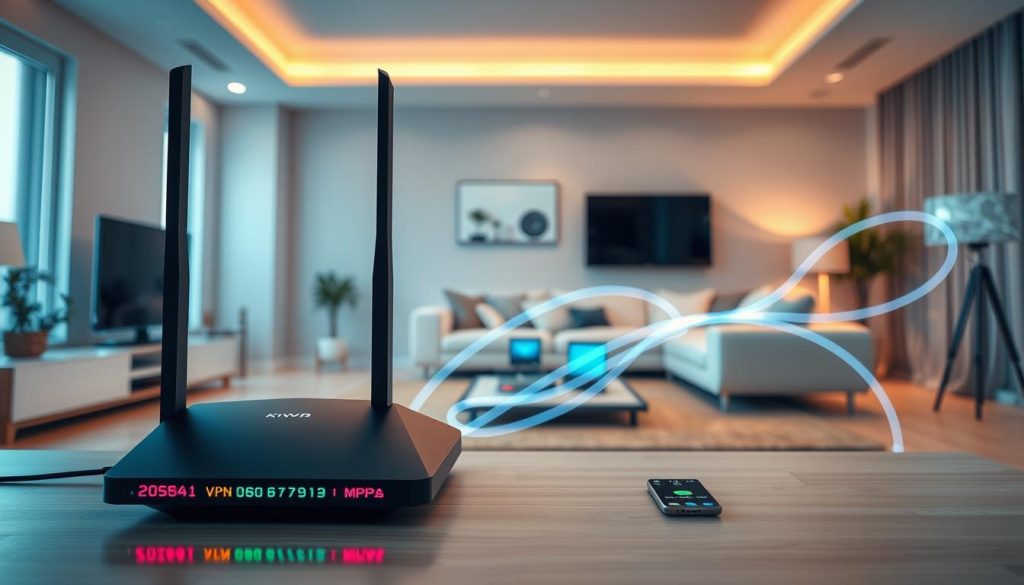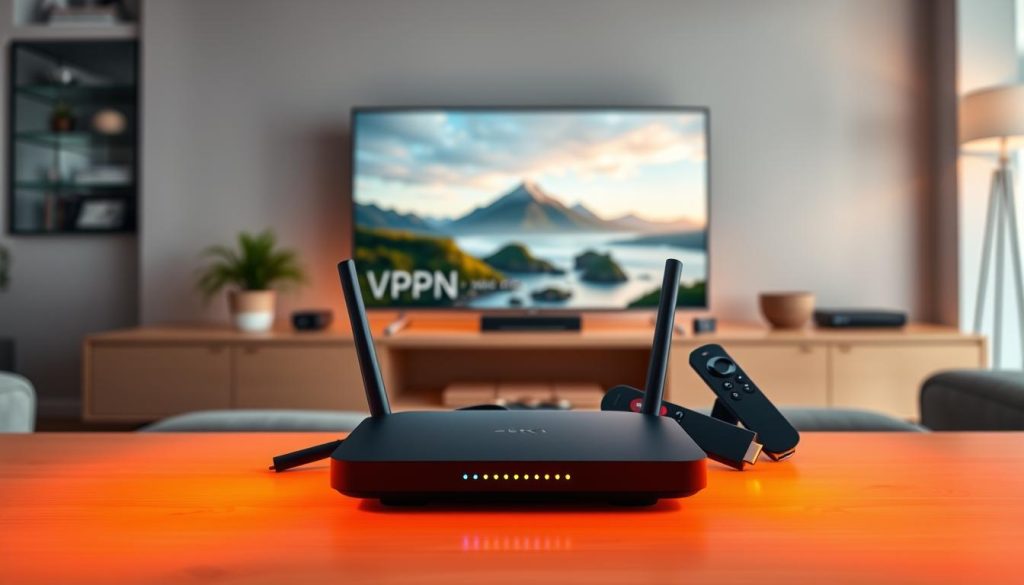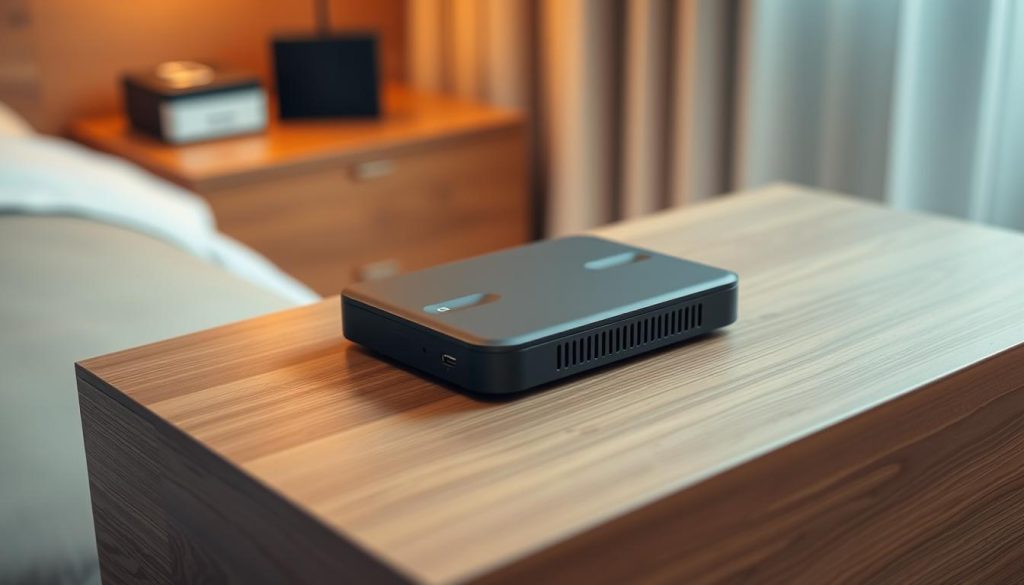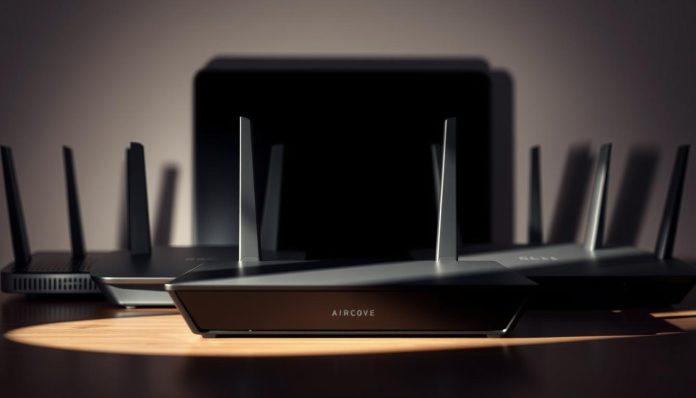You need a clear way to protect a house full of streaming boxes, consoles, smart speakers, and other IoT gadgets. Putting a vpn at the gateway secures every device with one setup, removing the need to install apps on gear that cannot run them.
One option is a purpose-built product that bundles an integrated vpn, device grouping, ad blocking, threat filtering, and parental rules for easy control. Another path uses a conventional router with free security suites and manual vpn installs for granular networking choices.
In this guide you will see how those choices affect real-world throughput, coverage, cost, and day-to-day setup. We also summarize independent speed checks and practical trade-offs so you can pick the option that fits your household and streaming or gaming needs.
At a glance: who should pick Aircove vs a traditional router
Deciding between an all-in-one VPN gateway and a feature-rich standalone router comes down to how much time you want to spend on setup.
If you want a plug-and-play product that protects every device out of the box, choose the integrated gateway. It pairs Wi‑Fi 6 with built-in vpn service, device groups for per-location rules, ad blocking, Threat Manager, and parental controls. Coverage is around 1,600 sq ft, with a free trial and long‑term plans from about $3.49/month.
Pick a standalone router when hardware flexibility matters. Models like the ASUS RT‑AX1800S, ROG GT‑AX11000, or TP‑Link Archer AX11000 offer free security suites, multi‑gig ports, more LAN options, and mesh expandability.
In short: go with the all‑in‑one if you want quick setup, centralized controls, and easy region switching. Choose a traditional router if you prefer mix‑and‑match vpn service choices, advanced QoS, or future-proof networking options.
- Quick setup and centralized rules: all‑in‑one top pick.
- Hardware flexibility, ports, and advanced tuning: choose a standalone router.
ExpressVPN Aircove vs Traditional Routers: Best Smart Home Protection?
A single gateway approach can simplify privacy and filtering for all your devices.
Putting a vpn at the router level protects smart TVs, consoles, and IoT without installing clients on each gadget. An integrated product that bundles a vpn service, DNS blocking, and Threat Manager reduces manual steps and shrinks the attack surface.
Many mainstream vendors include free antivirus suites and parental controls, but they often require you to add WireGuard or OpenVPN profiles manually. That extra setup can deliver similar defense over years, yet it demands more hands‑on maintenance.
Match coverage to your floor plan: the integrated device handles about 1,600 sq ft for small to medium homes. Real-world protection still depends on regular audits, speed headroom, and the ability to switch locations for content access.
- Gateway simplicity: always‑on vpn and DNS filtering for every device.
- Traditional gear: flexible hardware, manual vpn setup, and layered security suites.
Security first: built-in VPN vs free router security suites
Security starts at the network edge, so compare how integrated services and bundled suites guard your devices.
The built‑in vpn option layers audited privacy controls: multiple third‑party audits, repeated KPMG checks of the no‑logs policy, and RAM‑only servers. Its DNS filtering and Threat Manager block malicious domains before traffic reaches a device.
By contrast, many consumer router suites use established antivirus engines like Trend Micro to scan and quarantine infected gear. Those bundles add parental controls and site blocking, which help nontechnical households.
- Reduce misconfiguration: integrated vpn lowers setup errors for busy homes.
- Layer defenses: router suites can complement vpn privacy with device quarantine.
- Avoid double filtering: disable overlapping DNS blocks if you see slowdowns.
| Feature | Built‑in VPN | Router Security Suite |
|---|---|---|
| Independent audits | 23+ third‑party audits, RAM‑only servers | Relies on AV vendor reputation (Trend Micro, etc.) |
| Threat blocking | DNS‑level blocking, malicious domain filter | URL filtering, malware quarantine, signature updates |
| Misconfiguration risk | Low — centralized defaults | Higher — manual OpenVPN/WireGuard setup may be needed |
| IoT coverage | Always‑on gateway filtering for all devices | Covers devices via network scans and DNS rules |
Speed and performance: Mbps you can expect in real homes
Your usable Mbps depends on radio range, VPN protocol, and how many devices share the air.
Measured Wi‑Fi shows big falloff with distance. Non‑VPN peak on the integrated gateway hits about 1,200 mbps, with 5 GHz tests near 845 Mbps at 2 ft, ~637 Mbps at 40 ft, and ~191 Mbps at 120 ft.
VPN choice shifts those numbers. WireGuard‑style implementations often sustain near‑gigabit speeds on capable hardware, while OpenVPN commonly drops throughput into the low‑hundreds mbps range.

Real tests: one provider approaches ~898 Mbps peak with native clients, OpenVPN tops ~160 Mbps, and other vendors using WireGuard/NordLynx or similar hit 950+ Mbps. Surfshark WireGuard results mirror that, while its OpenVPN numbers are lower.
| Scenario | Typical peak (mbps) | Notes |
|---|---|---|
| Non‑VPN 5 GHz (close) | ~845–1200 | High raw throughput; optimal line of sight |
| WireGuard/NordLynx on router | ~900–950+ | Near‑gigabit on modern hardware |
| OpenVPN on router | ~160–460 | CPU and protocol overhead limits speed |
Tuning tips: place the router centrally, pick cleaner channels, and use Ethernet backhaul for fixed devices to preserve speed headroom for streaming and cloud gaming.
Coverage and device density for modern smart homes
Square footage, wall materials, and how many devices you run shape the coverage you need. A single gateway that lists up to 1,600 sq ft may suit many apartments and small houses.
For multi‑story layouts or wider floor plans, favor a router that supports mesh expansion. Systems with AiMesh or vendor mesh let you add nodes to keep coverage consistent without losing speed.
Pay attention to antenna design and spatial streams. More streams and better radios help crowded networks handle many always‑on sensors and streaming boxes. Also use band steering or separate SSIDs so low‑bandwidth IoT stays on 2.4 GHz while 5 GHz serves gaming and video.
- Map your home layout and count always‑on devices to judge if 1,600 sq ft is enough.
- Choose mesh‑capable routers for large or multi‑story homes to avoid dead zones.
- Place nodes centrally and plan channels to reduce interference from neighbors.
| Option | Typical coverage | Best for |
|---|---|---|
| Single integrated gateway | Up to 1,600 sq ft | Apartments, small houses with moderate device counts |
| Mesh‑capable router system | Expandable to full multi‑story homes | Large houses, many concurrent devices |
| Mesh with parental/management features | Variable by nodes | Families needing device grouping and controls |
Practical tip: run a quick speed and signal test in each room after setup. If vpn routing adds load, prioritize wired backhaul for high‑bandwidth devices to preserve internet performance.
Setup and ease of use: from web browser dashboards to wizards
A smooth first-time setup makes it far easier to keep your devices safe and online. Guided onboarding cuts friction so you finish basic tasks in minutes.
Plug-in gateways simplify the setup. A central web dashboard walks you through Device Groups, server selection, and basic controls. The process is visual and needs few manual steps.
By contrast, many consumer router models offer setup wizards that help with wireless names and passwords. Enabling a vpn client on those boxes usually requires downloading OpenVPN or WireGuard files, importing them into the router, and verifying routing.
Decide whether you prefer the vendor app or a web browser for advanced options. Use the browser for firmware updates, diagnostics, and parental controls when you want full visibility.
- Guided onboarding: fewer clicks, lower error risk.
- Manual client setup: more flexibility but more steps.
- Look for clear labels, stable firmware, and rollback options.

Finally, 24/7 live support and a solid knowledge base save time when protocols or DNS behavior act up. Good vendor support turns a tricky setup into a reliable network.
Privacy posture and audits: provider trust you can verify
Audits and transparency reports give you clear signals about a vpn provider’s privacy posture.
Look for repeated third‑party tests and public reports. One major provider lists 23+ audits, including a KPMG no‑logs review. Another completed its fifth Deloitte audit and emphasizes RAM‑only servers. A third offers open‑source apps, annual audits (Securitum 2024), and Swiss jurisdiction.
RAM‑only architectures matter for router‑level deployments because they avoid persistent storage. If a server reboots, no logs remain. That lowers long‑term risk when you run an always‑on gateway at home.
- Audit depth: repeated reviews beat a single report.
- Infrastructure: RAM‑only servers reduce data exposure.
- Jurisdiction: transparency and laws shape real‑world handling.
| Aspect | What to check | Why it matters |
|---|---|---|
| Audits / tests | Frequency and auditor name | Validates no‑logs claims |
| Server design | RAM‑only vs disk | Limits persistent data |
| Transparency | Reports, open apps | Shows ongoing support and trust |
In short, favor services with repeated audits over years and clear technical choices. That gives you more confidence when the vpn runs at your network edge.
Streaming and geo-content: how each option handles Netflix and more
How a gateway assigns locations to each device can save you from constant app sign‑outs and region toggles.

Major providers reliably reach Netflix, Amazon Prime, Disney+, BBC iPlayer, and ITV. Per‑device location controls let one TV use the U.S. catalog while another uses the U.K. without extra apps.
Higher throughput from modern protocols like WireGuard/NordLynx improves multi‑device 4K stability. NordVPN and Surfshark show near‑gigabit WireGuard speeds, while one vendor hit ~898 Mbps in tests.
If you prefer a standalone router, you can match this by pairing fast vpn services and setting DNS correctly. That takes extra setup but yields similar playback across many devices.
- Pick nearby servers to lower latency and buffering.
- Use Ethernet for your main streaming boxes when possible.
- Check DNS so apps can verify regional subscriptions.
| Task | Gateway per‑device | Standalone router |
|---|---|---|
| Region switching | Assign default locations per device | Requires client or profile per device |
| Throughput for 4K | Near‑gigabit with modern vpn protocol | Comparable if paired with fast service and firmware tuning |
| Quick fixes | Switch device location in dashboard | Change server on router or device app |
Gaming priority: latency, stability, and split tunneling
Competitive play demands a network that keeps ping low and jitter out of your match.
If you run a vpn at the gateway, you can route most devices through encrypted tunnels and keep your console or PC outside that tunnel to shave milliseconds.
The ASUS ROG Rapture GT-AX11000 brings gaming acceleration, multi‑gig ports, and VPN Fusion so you can assign separate tunnels per device. The integrated gateway’s Device Groups give similar per‑device routing with fewer steps.
Prioritize a wired multi‑gig port for your main rig to steady ping and reduce jitter. Use QoS to push game traffic ahead of backups and streaming. Pick lower‑latency vpn servers only for devices that need privacy; keep game backends on nearby direct routes.
| Feature | Gaming router (ASUS) | Integrated gateway | Impact on gaming |
|---|---|---|---|
| Per‑device split tunneling | VPN Fusion — manual, flexible | Device Groups — simple, guided | Fine control vs easier setup |
| Ports / wired | Multi‑gig LAN for stable connection | Gigabit LAN suitable for most use | Better wired links cut latency |
| QoS & acceleration | Advanced tuning for low ping | Basic prioritization and rules | Advanced features favor competitive play |
Choose a traditional gaming router when you need deep tuning and high‑end ports. Pick the simpler gateway when you want per‑device privacy with minimal maintenance.
Travel and portability: bring your VPN router on the road
On trips, a small vpn router simplifies captive portals and keeps every device on a single, protected network.
The compact Aircove Go retails near $170 and includes a 30‑day ExpressVPN trial, making it a plug‑and‑play travel choice for quick hotel privacy.
For more flexibility, the GL.iNET Beryl‑AX supports OpenVPN, WireGuard, and OpenWRT. It has Ethernet and USB ports and can be preconfigured with major services before you leave.

On the road you’ll value easy captive portal handling, the ability to share one paid hotel connection across phones and laptops, and a simple web dashboard to switch profiles from your phone.
- When to pick Ethernet/USB: choose units with ports if you need wired uplinks or local storage access.
- When to choose small form factor: pick the tiny unit if weight and pocketability matter more than extra ports.
- Preconfiguration saves time; support for multiple vpn profiles lets you change providers or regions quickly.
| Travel need | Compact unit (trial included) | Versatile GL.iNET |
|---|---|---|
| Price | ~$170 | Varies by model |
| Protocol support | Built‑in client | OpenVPN, WireGuard, OpenWRT |
| Ports | Minimal | Ethernet + USB |
| Best for | Quick setup and hotel Wi‑Fi | Advanced preconfiguration and flexible uplinks |
Total cost of ownership: hardware price, VPN subscription, and time
Total ownership is more than the box price — it includes subscriptions, updates, and the time you invest.
Start by comparing the upfront price of a gateway (~$190 with a free trial) against typical router buys. Entry units like the RT‑AX1800S run near $70. High‑end gaming router models rise to $250–300.
Next add recurring costs: vpn subscription plans can fall to about $3.49 per month on long deals, or you can use bundled years from vendors. Some routers include free lifetime security suites or one‑year vpn bundles that offset subscription fees.
- Budget pick: low hardware price plus free suite.
- Midrange: flexible protocol support and modest subscription.
- Premium: multi‑gig features, higher router cost, and top vpn performance.
| Item | Typical cost | Why it matters |
|---|---|---|
| Hardware price | $70–$300 | One‑time outlay |
| VPN subscription | $3.49 per month (long plan) | Ongoing privacy and region options |
| Time & maintenance | Hours to set up | Less time saves support calls |
Finally, weigh intangible value: simpler setups cut time and support needs. That convenience can justify a higher initial price if it reduces headaches later.
Smart home and IoT protection: blanket coverage for every device
Putting encryption and DNS filtering at the router means devices without apps inherit your privacy automatically.
That approach extends vpn privacy to TVs, consoles, cameras, and small sensors that cannot run clients. It also reduces the chance a compromised device can reach other gear on your network.
Segment your network to limit lateral movement. Create a dedicated SSID for IoT and a guest network for visitors. Use strong, unique credentials and disable unused services to shrink attack surface.
- Use device groups or VLANs to isolate cameras and sensors from phones and laptops.
- Enable DNS‑level threat blocking and ad filtering at the gateway to cut tracking and malicious content across the internet.
- Keep firmware updated and apply parental or quarantine rules where available.
| Feature | VPN at gateway | Router security suites |
|---|---|---|
| Device coverage | All connected devices inherit vpn and DNS rules | Scans and isolates infected clients |
| Threat blocking | DNS‑level blocking across the network | URL filters, malware quarantine, parental policies |
| Practical use | Simple per‑device location and policy | Complementary quarantining and advanced controls |
Tip: combine both: run vpn at the edge and enable router security features like client isolation. This dual approach gives broader privacy and stronger local threat response.
Top picks roundup: best fits by use case in the U.S. today
This compact list maps common household needs to one clear top pick and other strong options. You’ll get one best match for plug‑and‑play privacy, gaming, budget security, and travel.
Use the entries below to shortlist quickly. Each row notes standout features, who benefits most, and an indicative price so you can compare service and price without digging through specs.
| Model | Best for | Standout feature | Price range |
|---|---|---|---|
| Aircove | Plug‑and‑play privacy | Device grouping; easy vpn setup | $190 |
| Aircove Go | Travel | Portable unit with 30‑day trial | ~$170 |
| ASUS ROG GT‑AX11000 | Advanced gaming | VPN Fusion for split tunneling | $300+ |
| ASUS RT‑AX1800S | Budget security | Free AiProtection suite | $70 |
| GL.iNET Beryl‑AX | Portable multi‑vpn support | OpenVPN/WireGuard/OpenWRT | $100–$150 |
When coverage is tight, add mesh nodes. If you need multi‑gig ports or advanced controls, step up to a higher tier router. This short list helps you match real needs to practical options fast.
Advanced options: multi‑VPN, multi‑WAN, and custom firmware
If you need per‑device tunnels, multi‑WAN failover, or a personal vpn server, higher‑end router choices give you those tools. You can run a vpn client for commercial services and also host a vpn server to reach your home from anywhere.
Use ASUS VPN Fusion or policy‑based routing to place different devices on separate tunnels. That keeps work machines on a direct link while phones use a privacy tunnel. GL.iNET and many models support OpenWrt for deep customization.
- Multi‑VPN: assign tunnels per device or group with a vpn client profile.
- Multi‑WAN: add failover or load balancing to keep uptime for home offices.
- Custom firmware: DD‑WRT, OpenWrt, Asus Merlin, or pfSense add logging, QoS, and advanced routing.
- Physical layout: multi‑gig WAN/LAN ports and VLANs to segregate IoT from work gear.
| Capability | Typical use | Why it matters |
|---|---|---|
| Multi‑VPN / per‑device | Gaming, work, streaming split | Fine control without extra apps |
| Multi‑WAN | Failover / load share | Keeps business traffic online |
| Custom firmware | Advanced logs & QoS | Greater tuning and long‑term support |
How we map your needs to the right router and VPN client
Start by listing every device, where it lives, and how you use the network daily. That inventory reveals coverage gaps and which features matter most, such as parental controls, streaming region switches, or wired ports.
Next follow a simple process: match must‑have features, decide if a dedicated VPN router or a traditional box with a configured vpn client fits your comfort level, and check provider documentation and support before you buy.
Prioritize long‑term ease. Pick hardware with stable firmware, clear dashboards, and vendor support you can call on. Our testing across years shows that good documentation saves time and reduces misconfiguration.
- Inventory devices and coverage needs.
- List required features and tolerance for hands‑on setup.
- Verify the service’s setup guides and live support options.
- Choose firmware with regular updates for long‑term ease.
| Step | Why it matters | What to check |
|---|---|---|
| Device audit | Sets range and port needs | Count phones, TVs, cameras |
| Feature match | Keeps setup minimal | Per‑device rules, split tunneling |
| Support & service | Speeds troubleshooting | Guides, chat, forum response times |
Conclusion
Balance convenience, performance, and cost to pick the right approach for your network. In practice, a clear choice comes down to how much time you will spend on setup and tuning, and what you expect from your internet connections.
.
If you want plug‑and‑play ease, a purpose‑built gateway like Aircove bundles an integrated ExpressVPN client, device grouping, ad blocking, and simple controls for about 1,600 sq ft of coverage.
Choose a traditional router when you need deeper networking tools, free lifetime security suites, or hardware flexibility for future upgrades. Modern protocols and capable hardware deliver the best speeds, but they need more hands‑on work and occasional firmware care.
Factor total price, the vpn service plan, and your time. With clear expectations and verified tests, you’ll end up with a secure setup that fits your devices and daily internet experience.

